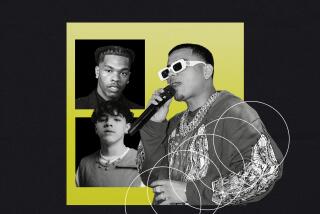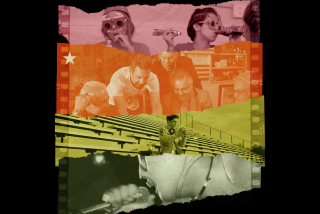FOOT-STOMPIN’ TIME AS TIJUANA GOES COUNTRY
- Share via
TIJUANA — Since the start of June, there’s been a big dance contest going on here with a grand prize no self-respecting vaquero, or cowboy, can resist: a mare valued at $5,000.
So take it on faith that every Tuesday night from 9 p.m. to 3 a.m., practically every 10-gallon hat in Tijuana is at La Cueva del Dragon (the Cave of the Dragon), a gritty Western honky-tonk on Agua Caliente Boulevard.
Barrel-chested Bobby Cardoso and his band, El Golpe (the Hit), provide the beat: rip roarin’, bronco bustin’, cattle brandin’ Norteno music, Mexico’s raucous answer to American country-western. The stuff that put the “Mex” into Tex-Mex.
And the audience provides the feet: boot-clad feet that click and clack, push and pound against the hardwood dance floor with the aggressive determination of Italian grape-stompers after the vineyard harvest.
Each week, contestants go through three routines: the slow chotis, the midtempo polka, and the quick-footed calabaceado.
The winning couple, chosen by audience applause, receives a suede-leather vest, a pair of cowboy boots and a leather handbag.
But more importantly, they get an invitation to the finals, scheduled for the last Tuesday in July.
That’s when the grand prize-winning pair gets the expensive horse.
Norteno music originated more than a century ago in the northern Mexican states of Baja California, Sonora, Chihuahua and Coahuila, which border the United States.
It’s similar to American country-western music in that its progenitors were the cowboys who worked on the large rancheros along the border; like their U.S. counterparts, they sang wistful musical corridos, or tales, about frontier heroes, tavern girls, lonely days herding cattle, and wild nights drinking in the nearest cantina, or saloon.
The instruments and rhythms, however, are different: American country-western relies heavily on the six-string guitar and the banjo, while Norteno music places most of its emphasis on the 12-string guitar and the accordion.
And the plodding beat of most American country-western songs is a lot more laid-back than the spicy, festive rhythms of Norteno music.
Cardoso and the six other members of El Golpe have been playing Norteno music for eight years, ever since John Travolta and the “Urban Cowboy” movie gave many people a bad case of cowboy fever.
In the United States and most other countries, the fad faded as quickly as it had arrived.
But in Mexico, particularly Tijuana and other northern cities--where there are still more cowboys riding the range than in all Gene Autry westerns combined, where rodeos are as popular as Van Halen concerts, where countless cowboy associations meet as regularly as the Rotary Club--the country craze has yet to lose its momentum.
“It’s not a fad for us, but it’s a fad among the people in general,” Cardoso, 31, said between sets. “In the northern states especially, it’s extremely popular right now with all the people--not just ranchers and cowhands, but bankers and others in the upper middle-class.
“Even the cowboy associations around Tijuana have members who aren’t really cowboys: They could do anything (as a profession), but they like the life style, the fashion, and the music.”
Cardoso said there are more than 20 bands in Tijuana that play Norteno music; his is among the oldest and the most popular.
Hence, the dance contest--and the jam-packed house on a relatively quiet Tuesday night.
About half an hour after going back up on stage, Cardoso, wearing his cowboy finest--straw hat, leather vest, and polished boots--put down his accordion. Taking his cue, his fellow band members laid down their respective instruments as well: guitars, bass, and a cow bell or two.
By the time El Golpe’s lead singer got around to announcing the start of the evening’s competition, more than a dozen couples had already taken their place on the dance floor.
And a club employee was already halfway through his rounds of tying numbered signs around each cowboy dancer’s neck with a cherry-red ribbon.
A few minutes later, the music began again. So did the dancing. One by one, couples were eliminated as they danced their way through the three routines until six were left. Then three. Then, after yet another round, only one.
The crowd erupted with applause, foot-stomps, and cheers. The prizes were handed out. But the winning cowboy’s intense eyes revealed his mind was somewhere else.
He was thinking about that horse.
More to Read
Sign up for Essential California
The most important California stories and recommendations in your inbox every morning.
You may occasionally receive promotional content from the Los Angeles Times.










